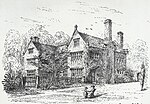Llong railway station
Disused railway stations in FlintshireFormer London and North Western Railway stationsPages with no open date in Infobox stationRailway stations in Great Britain closed in 1917Railway stations in Great Britain closed in 1962 ... and 3 more
Railway stations in Great Britain opened in 1849Railway stations in Great Britain opened in 1919Wales railway station stubs

Llong railway station was a station in Llong, Flintshire, Wales. The station was opened on 14 August 1849 and closed on 30 April 1962. The station building is now a private residence.In 1947 there were 8 trains a day each way.
Excerpt from the Wikipedia article Llong railway station (License: CC BY-SA 3.0, Authors, Images).Llong railway station
Alyn Lane,
Geographical coordinates (GPS) Address Nearby Places Show on map
Geographical coordinates (GPS)
| Latitude | Longitude |
|---|---|
| N 53.153 ° | E -3.1062 ° |
Address
Alyn Lane
Alyn Lane
CH7 4JR , Leeswood and Pontblyddyn
Wales, United Kingdom
Open on Google Maps










